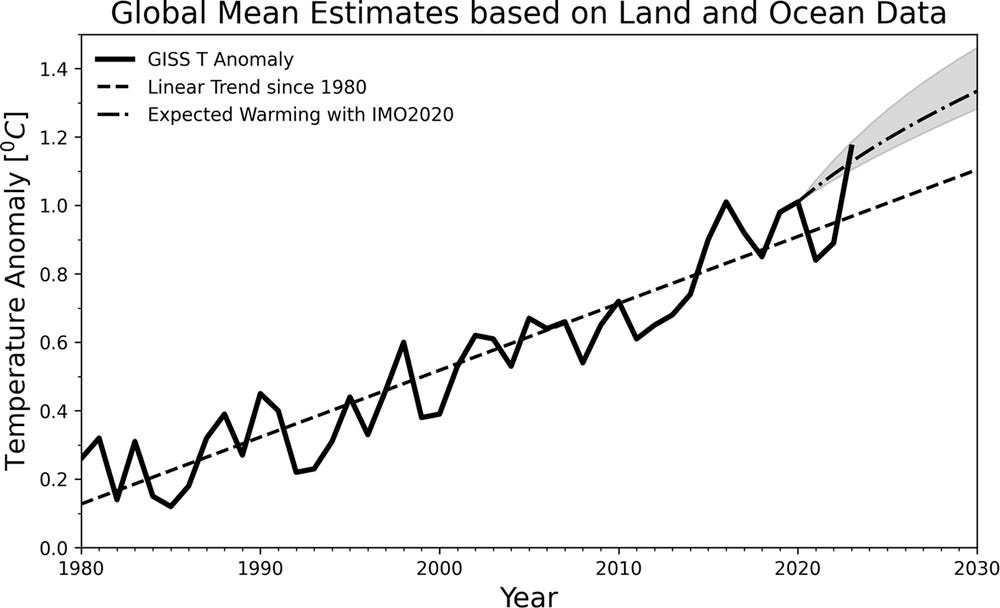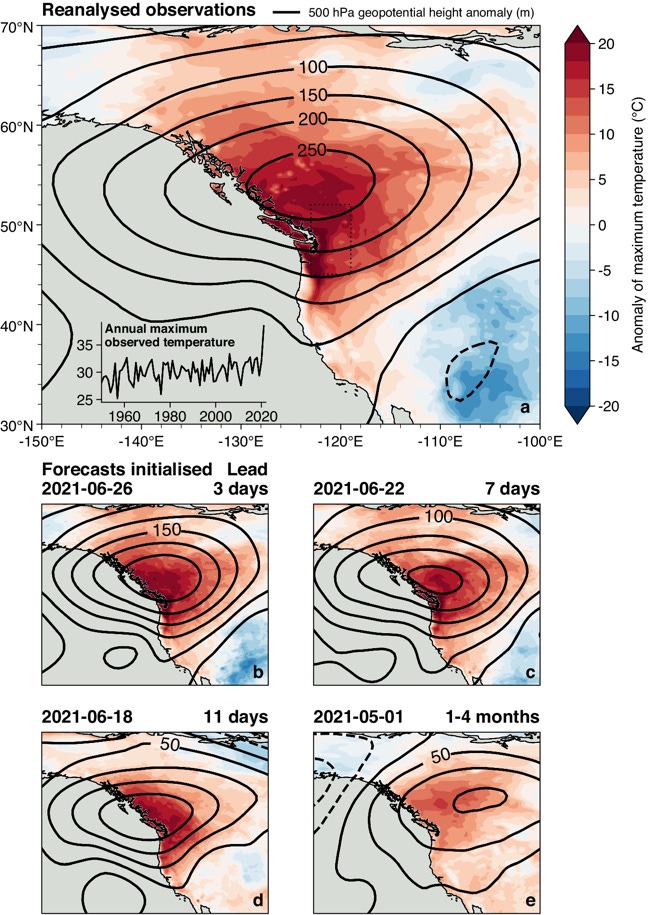
TL;DR: Here’s the top six news items of note in climate news for Aotearoa-NZ this week, and a discussion above between Bernard Hickey and The Kākā’s climate correspondent Cathrine Dyer:
New evidence is increasingly pointing at efforts to reduce marine pollution being the main cause of abrupt increases in ocean temperatures experienced since 2023. A new study in the academic journal Nature claims that the abrupt reduction in sulphur aerosols from marine shipping has inadvertently created a ‘geoengineering termination shock’ that could double the rate of warming in the 2020s.
The findings correlate with warnings from climate scientist James Hansen, lead author of a 2023 article ‘Warming in the Pipeline’ that challenged the consensus position on climate sensitivity and the rate of warming.
In a commentary published online in May, Hansen pointed out that “ship emissions are a tiny part of total anthropogenic emissions and of emission changes, but ships emit into relatively pristine ocean air and the aerosol effect is nonlinear”.
Both Hansen and the authors of the new study suggest that the current cloud dimming effects also demonstrate the potential for geoengineering such as marine cloud brightening (MCB) to temporarily offset global warming.
The dangers of attempting to do so were addressed by Aotearoa New Zealand climate scientist Kevin Tremberth in this Newsroom article earlier this year.
Another recent study looks at the triple threat posed to oceans from the combined effects of extreme heat, oxygen loss and acidification.
(See more detail and analysis below, and in the video and podcast above. Cathrine Dyer’s journalism on climate and the environment is available free to all paying and non-paying subscribers to The Kākā and the public. It is made possible by subscribers signing up to the paid tier to ensure this sort of public interest journalism is fully available in public to read, listen to and share. Cathrine wrote the wrap. Bernard edited it. Lynn copy-edited and illustrated it.)
1. Less sulphur = dimmer clouds = hotter oceans
New evidence is increasingly pointing to the deliberate reduction in marine pollution being responsible for the abrupt increase in ocean surface temperatures, particularly in the North Atlantic, since 2023.
In the chart below, the dashed lines on either side of the 1982-2011 mean temperature represent a 2-sigma standard deviation. The remarkable 2023/24 temperatures, shown in solid orange/black sit outside the 4-sigma envelope demonstrating the sheer scale of the increase.
According to this article in the American Meteorological Journal, the extreme ocean temperatures experienced since 2023 are more in line with average global warming levels of 3.0˚C than 1.5˚C.
Now, a new study published in the journal Nature last week, claims that an abrupt reduction in marine pollution inadvertently created a ‘geoengineering termination shock’ that could double the rate of warming in the 2020s.
In January 2020, new International Maritime Organisation (IMO) regulations (abbreviated to IMO2020) took effect, reducing the sulphur content in international shipping fuels from 3.5% to 0.5%.
The intention was to reduce aerosol loadings that have negative consequences on human health. However, aerosols also contribute to cloud formation and brightening, which reflect solar radiation back into space.
Thus, human activity in the form of marine pollution or aerosol loading has been having a cooling effect on global climate for decades by temporarily brightening clouds. The recent reduction in aerosols has dimmed clouds, which has increased the amount of radiative forcing that reaches the surface of the ocean.
The study combined satellite observations with a chemical transport model to quantify the amount of radiative forcing caused and to estimate the climate impacts. The study found that the North Atlantic experienced the strongest warming effects, with weaker but ‘still notable’ radiative forcing experienced in the North Pacific and South Atlantic. This is consistent with the amount of shipping traffic and cloud cover in those regions.
“The IMO2020 is expected to provide a substantial boost to the warming rate of global mean temperature in the 2020s. The rate of warming is expected to ramp up quickly from 2020 and asymptotes to the longer-term trend line at the end of 2020. The 2023 record warmth is within the ranges of our expected trajectory. The magnitude of IMO2020 induced warming means that the observed strong warming in 2023 will be a new norm in the 2020s.”
The chart below, shows the projected impact on global temperatures.
Fig. 3: Time series of global temperature anomaly since 1980 (Lensen et al., 2019).
The trend line is dashed. The expected warming trajectory from the combination of the linear trend and the calculated warming effect from IMO 2020 shock based on the energy balance model. The upper and lower bounds of the expected warming are shown in shades. The baseline period for temperature anomaly is between 1951 and 1980.
The findings of the study correlate with commentary from climate scientist James Hansen, who commented in May,
We interpret acceleration of warming since 2010 to be a consequence of decreasing aerosols, with a significant contribution from reduction of ship aerosols due to the strict 2020 emission limit imposed by the IMO (International Maritime Organization). Another recent social media comment is that reduction of ship emissions is negligible compared to emission reductions by China. That comment misses the point. It is well known that ship emissions are a tiny part of total anthropogenic emissions and of emission changes, but ships emit into relatively pristine ocean air and the aerosol effect is nonlinear. The inadvertent experiment provided by the IMO emission limit is a great opportunity to improve understanding of aerosol and cloud physics.
The study also echoes this comment from Hansen about the implications of aerosol forcing estimates on the estimated range for climate sensitivity (how much the planet warms when CO2 emissions are doubled):
Accurate evaluation of humanmade aerosol forcing has double importance because of implications for climate sensitivity, as we have discussed elsewhere. If IPCC has underestimated aerosol forcing, they probably have also underestimated climate sensitivity.
2. Can we deliberately geo-engineer the clouds?
The study authors say that this inadvertent geo-engineering experiment indicates that deliberate efforts to reduce the rate of global warming through marine cloud brightening (MCB), where marine low clouds are seeded with aerosols to become brighter, could be used to temporarily cool the climate.
Hansen advocated for geo-engineering to temporarily reduce global temperatures in his ‘Global Warming in the Pipeline’ paper, published in 2023. It is worth noting that Yuan et al. (2024), the authors of the new paper cited above, highlight the different hemispheric effects of the current reduction in radiative forcing.
The effects have been much stronger in the Northern hemisphere than the Southern, and such contrasts between hemispheres have implications for regional climate and precipitation.
Any deliberate effort to geo-engineer the climate using MCB could create ‘severe perturbations’ in monsoon and other substantial rain patterns if it changed the contrast between hemispheres, they say. This would, in turn, impact regional agriculture and food security, not to mention potentially aggravating geo-political tensions.
The current inadvertent geo-engineering experiment highlights both the possibilities and the risks of attempting to manage the climate. One of Aotearoa New Zealand’s own globally renowned climate scientists, Kevin Trenberth, is worth paying attention to on this subject.
In this article for Newsroom, Trenberth uses the following fable to illustrate the very human dangers of deliberately changing the climate in ways that will inevitably benefit one group at the expense of others.
“Once upon a time in an idyllic country, near a small town and a farming community, a rope hung out of the sky. One pull on the rope changed the weather from fine and sunny to cloudy and rainy, and the next pull changed it back. For many years the people cooperated; the farmers used the rains to help grow crops, and the townspeople enjoyed the sunny periods. But there came a time when the townspeople protested the rain and wanted more sunshine. The farmers were concerned about their crops. And so arguments broke out, with a person from the town pulling on the rope, followed quickly by a farmer pulling it again, and they pulled and pulled and . . . broke the rope.”
We should, according to Trenberth, “give up on the notion that geoengineering will save us from ourselves” and instead focus our attention on cutting emissions and fossil fuel use.
3. A revealing new way to forecast weather
In brighter news, a revolution in the field of extreme weather attribution is being heralded on the back of another study published in Nature this week.
The new approach uses state-of-the-art weather forecasting systems instead of climate models or statistical approaches to detect the physics of events.
Their analysis shows (chart below) that the 2021 Pacific Northwest heatwave was made at least 8 times more likely as a result of human influence on the climate, with the likelihood of such events doubling every 20 years in the future.
They claim that the use of such predictive services in routine weather forecasting would lay bare the human influence on extreme weather risk and provide critical support to adaptation planning.
Fig. 1: Features and forecasts of the Pacific Northwest heatwave.
From: Heatwave attribution based on reliable operational weather forecasts
4. The triple threat to our oceans
Extreme ocean heating has featured in other news this week. New research published in AGU Advances looks at the triple threat posed to oceans by extreme heat, oxygen loss and acidification.
About a fifth of the world’s ocean surface is particularly vulnerable to the three threats hitting at once, spurred by human activity such as the burning of fossil fuels and deforestation, the study found. In the top 300 meters of affected ocean, these compound events now last three times longer and are six times more intense than they were in the early 1960s, the research states.
The study’s lead author warned that the world’s oceans were already being pushed into an extreme new state because of the climate crisis. “The impacts of this have already been seen and felt,” said Joel Wong, a researcher at ETH Zurich, who cited the well-known example of the heat “blob” that has caused the die-off of marine life in the Pacific Ocean. “Intense extreme events like these are likely to happen again in the future and will disrupt marine ecosystems and fisheries around the world,” he added. The Guardian.
5. Hurricane warnings in the shadow of Trump
In addition, the record temperatures in the Atlantic have driven predictions of an above average hurricane season in the US from the National Oceanic and Atmospheric Administration (NOAA).
Scientists are warning the public to “expect a summer of natural disasters caused by the powerful storms”.
Such warnings are themselves at risk in an era of disinformation, as Trump allies threaten to disband the NOAA, potentially worsening society’s capability for addressing climate impacts in the US and beyond.
“The Project 2025 report takes aim at NOAA, suggests the National Weather Service commercialize its forecasting operations and says information from the National Hurricane Center should be “presented neutrally, without adjustments intended to support any one side in the climate debate.”
Reorganizing NOAA is a key component of these plans. The Project 2025 report says NOAA should be “broken up and downsized” because “its current organization corrupts its useful functions.”
The document describes the agency’s office of Oceanic and Atmospheric Research as the “source of much of NOAA’s climate alarmism” and says the “preponderance of its climate-change research should be disbanded.”” E&E News by Politico
6. Republicans look to shut down climate lawsuits
Finally, in other news out of the US, a new round of climate lawsuits against fossil fuel polluters is facing pushback from the political right.
Republican Attorney Generals (AGs) are asking the Supreme Court to intervene to prevent Democrat-led states from filing lawsuits in their own state courts against fossil fuel companies for damages from severe storms, wildfires and rising sea levels.
“The unusual request comes as dozens of states and local governments have filed lawsuits alleging that fossil fuel companies deceived the public about the risks of their products contributing to climate change. The lawsuits claim billions of dollars of damage from such things as severe storms, wildfires and rising sea levels.
The Republican action specifically seeks to stop lawsuits brought by California, Connecticut, Minnesota, New Jersey and Rhode Island, though lawsuits also have been filed by other states, tribes, counties and cities.
The GOP attorneys contend only the federal government can regulate interstate gas emissions, and states have no power to apply their own laws to a global atmosphere that reaches well beyond their borders. The court filing also contends the climate-related lawsuits could drive up energy costs in other states, including for electricity generated from natural gas.” The Independent.
Ka kite ano
Bernard and Cathrine



















Share this post